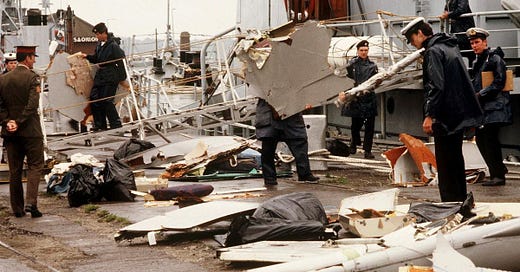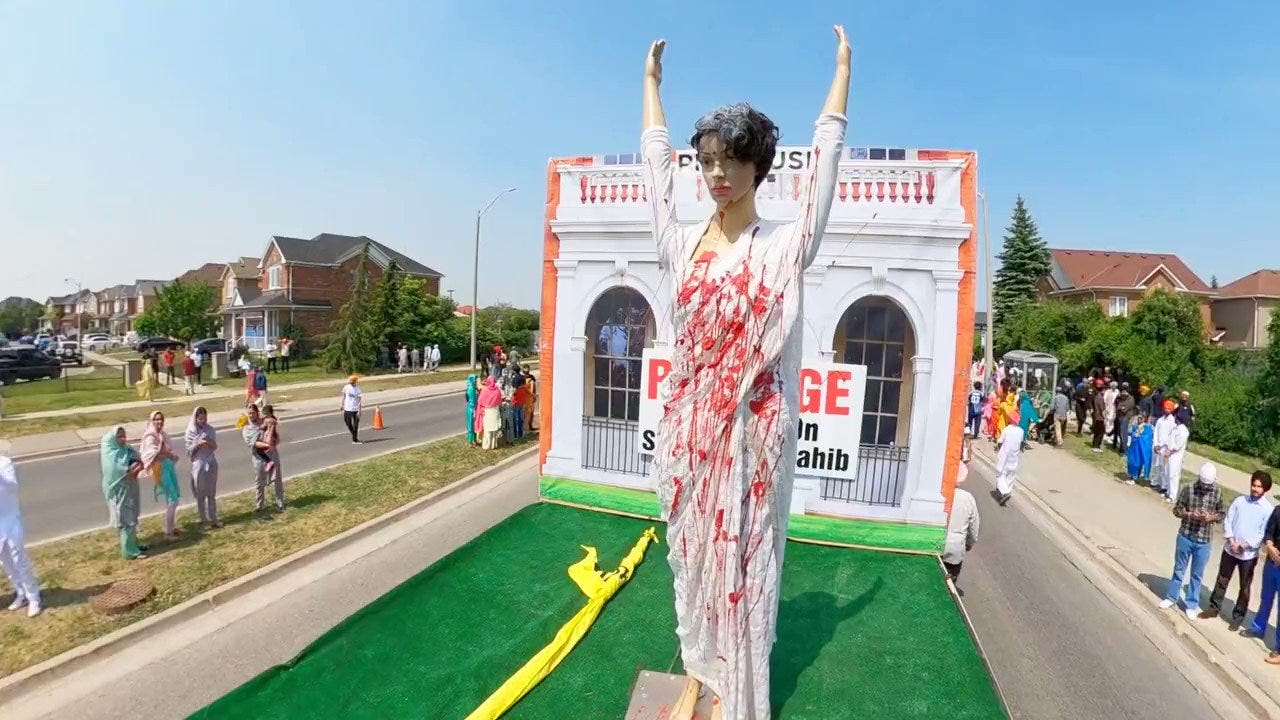The Worst Mass Murder in Canadian History
Today marks the anniversary of one of the 20th century's worst terrorist atrocities. It was plotted and planned in Canada: the murder of 329 people aboard Air India Flight 182. Meera Nair remembers.
A guest post today, in the form of an essay by my friend Meera Nair. No paywall.
By way of introduction, this is a personal story for me. Every year on this date I get a lump in my throat. I’m always haunted by the thought that I was among the Canadians who didn’t try hard enough, that back then I’d failed, as a journalist, and that failure contributed to that mass murder.
Of course that’s foolish, but the fact remains. I’d known the mastermind behind the Air India atrocity. I first interviewed Talvinder Singh Parmar when I was a boy reporter, five years before Air India Flight 182 fell from the sky and landed in the sea off Ireland’s Sheeps Head Peninsula.
My work covering the Khalistani fanaticism behind the bombing had brought me years earlier to India, to its heart of darkness: Jarnail Singh Bhinderenwale. Along with Parmar’s ruthless gang of murderers, the Khalistani Osama bin Laden had desecrated Sikhism’s holiest shrine, the Golden Temple at Amritsar, by turning it into a heavily fortified terrorist compound.
Freelancing for the Globe and Mail, I’d flown to and from India on that same Boeing 747, the Kanishka, that crashed into the sea that day off Dunmanus Bay. Only two days before the bombing I’d happened to be only a few sea miles away, visiting my Uncle Phil and my cousins in the town of Midleton in County Cork.
I awoke to the news in a London flat, and I won’t deny that I wept. And I’m still haunted by the thought that I was among ony a handful of journalists covering the story of the Khalistani separatists’ violent chokehold on Canada’s Sikh diaspora, and that my efforts had done nothing to properly alert the authorities. The Khalistanis had turned suburban Vancouver into their government-in-exile, and they were serious about their barbaric intentions. I’d failed, and the Air India atrocity was the result. Or so my dreary thinking went.

I was wrong about that. The RCMP and CSIS were closely watching the bombing mastermind Talvinder Singh Parmar and his accomplices all along. That’s who was at fault - CSIS and the RCMP and their masters in government. Still, while the Air India atrocity at last brought the story of Khalistani terror to the attention of dozens of Canadian journalists and high-powered newsrooms, it was the beginning of the end of my contribution.
I just couldn’t bring myself to cover the story anymore and I ended up handing all my files over to my colleagues at the Vancouver Sun, where I worked at the time. The irrepressible Kim Bolan is still on the story, and her courage and determination is a thing to behold.
The Khalistanis went on to murder my friend Tara Singh Hayer, editor of the Indo-Canadian Times. Another Khalistani well known to me, a guy convicted in the attempted murder of a Punjabi cabinet minister, ended up giving Canada a huge reputational black eye by showing up in the entourage Prime Minister Justin Trudeau brought with him for his catastrophic banghra-dancing magical mystery tour of India in 2018. That guy was Jaspal Singh Atwal.
It was a spectacular embarrassment that Trudeau made worse by disptatching his national security adviser, Daniel Jean, to peddle the most ludicrous nonsense to the Parliamentary press gallery.
I chronicled that episode for Maclean’s: Indian spies did it, and other Ottawa conspiracy theories. And here’s an explainer I wrote for the Ottawa Citizen: A short history of Canada and Khalistani terror. Read it after you’ve read Meera’s essay, if you like. It begins: Every now and then, a story will erupt out of nowhere that brings up horrible things we’ve all forgotten. . . A story, or an anniversary, like today.
The journalist who covered the whole Air India story more thoroughly than anyone else is former CBC veteran Terry Milewski. After reading Meera’s story, you might want to watch this documentary, an example of brilliant, thorough and gripping investigative reporting that Miliewski undertook for the CBC, Cover-up: Air India.
The Sheep’s Head Peninsula is a lovely place, sparsely occupied by decent, warmhearted people. There’s a shrine there to the dead. Among the 329 people on board the airliner that day, almost all of them were Canadians, mostly from the Toronto area. More than 80 were children. Six were babies.
But enough out of me. Here’s Meera.
Disinterest, Disdain, and An Extremism that Countinues to Flourish
by Meera Nair
Today marks the 38th anniversary of the bombing of Air India 182 and the murder of all 329 people aboard. Individuals within the Indian Canadian community had sought revenge for events that transpired in 1984 in India and chose to attack its national airline. That the travelers were innocent of any complicity with the Indian government made no difference to the terrorists.
The bomb detonated while the airliner was in flight off the coast of Ireland, with Canadians making up 280 of the dead. Two more innocent people died when a second bomb, destined for another Air India airliner traveling east, detonated on the ground in Tokyo’s Narita airport. Until the atrocities of September 11, 2001, the Air India bombing was the worst terrorist attack on civilian aircraft in history.
But the reaction across Canada was largely one of disinterest, an attitude that hardened into the disdain of successive Canadian governments that resisted exploring the circumstances around the bombing. It would be twenty years before Canada undertook a public inquiry into the outrage.
Despite the admirable work of Bob Rae and retired Supreme Court Justice John Major — each led comprehensive explorations into what happened, how Canada fell short, and the importance of remembering the people we lost and why we lost them — cultivating memory after the fact has proven to be inordinately difficult.
Setting aside for the moment how distressing this state of affairs is for all those who lost their loved ones in Canada’s worst mass murder, the matter should be remembered if for no other reason than to ensure it never happens again. The bombers were successful, in part, because Canadian authorities of the day were unwilling to cast a critical eye on the cultivation of enmity to India that was occurring in plain sight on the streets of Vancouver.
Even so, the extremist views that underwrote the bombing have largely been left free to multiply over the last 38 years.
If anyone doubts that statement, they need look no further than what happened in Brampton three weeks ago. It was a parade marking the anniversary of the Indian army’s Operation Bluestar. On June 4, 1984, under the orders of Prime Minister Indira Gandhi, the Indian army engaged in military action at Sikhism’s holiest site: the Golden Temple in Amritsar. The operation would lead to the assassination of Mrs. Gandhi. Her assassination was celebrated in Brampton as a righteous act of revenge.
The history told to Canadians is that in 1984, the Indian army ravaged the Golden Temple and massacred worshippers. Left unsaid is that a group of individuals who had been amassing arms within the Temple complex were committing terrorist murders across Punjab and using the sanctity of the Golden Temple as a refuge.
During Operation Bluestar, the Indian forces had largely complied with an order not to fire on the Temple itself. BBC journalists Mark Tully and Satish Jacob were on the ground in India during those turbulent years and detailed the fuller story in Amritsar—Mrs. Gandhi’s Last Battle (2006). It is a complicated tale; at one time, Mrs. Gandhi had been favorably inclined to the individuals that would later call for her death.
Those death threats emanated not only from within India, but in the diaspora. Fury was on display in the streets of Vancouver in 1984. And when the assassination occurred, Canadians were among those celebrating. Throughout, Canadian authorities tended to silence. That combination of celebration and silence was repugnant then, and in the wake of the recent display in Brampton, even more disturbing today. The number of individuals who spoke up immediately can be counted with a few fingers.
In an interview with Indian media, Brampton mayor Patrick Brown condemned the glorification of violence. He acknowledged the importance of freedom of speech but noted that our rights and freedoms are not absolute.
But the important question isn’t whether those parade organizers were acting within the bounds of freedom of expression, but rather why our prime minister and other senior members of the Government refrained from exercising theirs rights to free speech. A few days later Pierre Poilievre posted a statement; although devoid as it is of context, it reads more as a communiqué to India than to Canada.
There is a direct line between the blind eye Canada turned to the fomenting of domestic extremism, and the bombing of Air India Flight 182 on June 23 1985. That successive Canadian governments continued their attitude of disinterest is disturbing. No doubt many Canadian officials in 1985 were embarrassed - the bombing was clearly preventable, as later inquiries showed - but too many politicians of all parties simply did not and do not want to risk alienating a bloc of voters. Forgetting the Air India dead is apparently still more politically dvantageous than remembering them.
In an article for the Globe and Mail, written 25 years after the bombing, Patrick Brethour detailed the multiple themes that culminated in Canada’s disowning of the Air India victims. Among them, he noted that two dimensions of willful blindness characterized Canadian attitudes both before and after the bombing: a widespread ignorance of “the extent of radicalism within the Sikh community,” and, “an enduring denial that Canada could be a target, and a home, for terrorists.”
As Brethour also noted, there was one credible reason for authorities to tread carefully in this matter: the fear of tarnishing the entire Indian Canadian community by the actions of what was then, and still is, a small group among the larger community. But adopting silence on this topic, instead of investing in an effort of meaningful dialogue, has enabled misinformation to flourish.
Appeasing extremists, instead of engaging with all Canadians, has only made the situation worse.
June 23 marks the National Day of Remembrance for Victims of Terrorism, a day instituted expressly in memory of the victims of the bombing of Air India Flight 182. One can only hope that our political leaders acknowledge this day with sincerity.
Meera’s memorial to the Air India victims, and an archive of her efforts to keep their blessed memory among the living, is here.




Multicultualism means you never actually mentally and emotionally leave your home country when you move to Canada.
This has consequences.
...and Jagmeet Singh still won't decry it as terrorism.
Imagine if this had happened under Trudeau's government - the response would be to prohibit Canadians from flying, and confiscating planes from the airlines. Papa knows best!